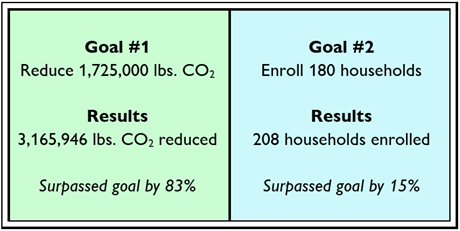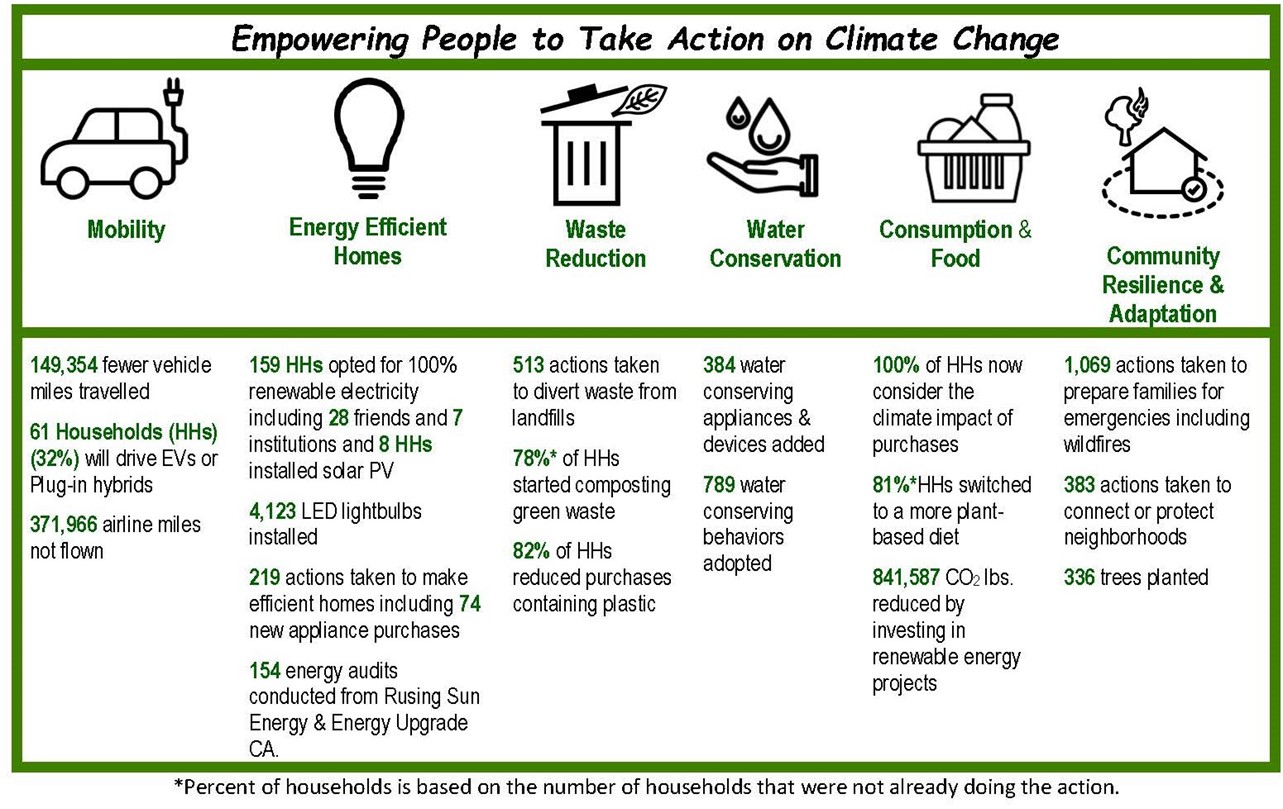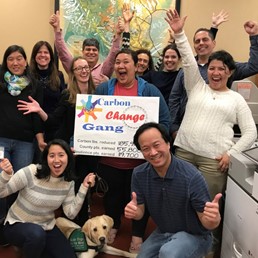Marin Grassroots Climate Action Program
CEC Local Government Challenge Grant: Integrated Climate Mitigation and Adaptation Case Study
Brief Summary
The countywide Marin Climate & Energy Partnership/Resilient Neighborhoods Grassroots Climate Action program significantly expanded an existing program that recruits and organizes households into Climate Action Teams to educate community members and help them reduce household greenhouse gas emissions and prepare for a changing climate.
The project ran from September 2017 to October 2019, and successfully motivated 208 households to reduce their household emissions, resulting in a collective reduction of more than 3 million pounds of carbon dioxide (CO2), a primary greenhouse gas. Households also earned points for resiliency measures, including over 1,000 individual actions to prepare for emergencies and wildfire and nearly 400 actions to connect with neighbors and protect their neighborhood. The project’s deliverables included a marketing and outreach plan, on-line program materials, a coach training handbook, and an impact and opportunities report.
The program supports state goals to reduce statewide greenhouse gas emissions 40 percent below 1990 levels by 2030 (SB 32, Pavley, California Global Warming Solutions Act of 2006, Chapter 249, 2016) and demonstrates how residential action is integral to meeting California’s climate goals.
Lead Agency and Partnerships
The lead agency for the project was the Marin General Services Authority (MGSA), a joint powers authority representing all Marin County local governments. MGSA served as the fiscal sponsor and contracting authority. The Marin Climate & Energy Partnership (MCEP), an MGSA-sponsored program through which the local governments coordinate climate action efforts, administered the program. MCEP worked with Resilient Neighborhoods, a program of Sustainable Marin, a local nonprofit, to implement the project. Resilient Neighborhoods provided program outreach and marketing, climate action team educational materials and instruction, and data tracking and analysis. Resilient Neighborhoods provided quarterly updates to MCEP, and MCEP members assisted Resilient Neighborhoods in outreach and marketing efforts.

Engagement Process
The engagement process focused on Marin County residents. Resilient Neighborhoods utilized a variety of marketing strategies to promote the program and sign-up participants, including 1) giving presentations to local governments, schools, and civic and religious organizations; 2) attending local events and conferences; 3) listing workshops in recreation guides; 4) promoting the program on the Resilient Neighborhoods website, and local government websites and newsletters; and 5) providing references from program graduates. The program is free to participants.
Households were organized into Climate Action Teams, which met five times over a ten-week period to learn about strategies and resources available to improve home energy efficiency, shift to renewable energy, reduce transportation emissions, conserve water, reduce waste, and build resiliency to climate-linked impacts. RN used proven social-based behavior change techniques, such as providing social connections, setting goals, seeking peer approval and help, and celebrating accomplishments. These techniques help to maximize program results and ensure long-term success.
Resilient Neighborhoods also recruited volunteer team coaches from the pool of program graduates and trained nine coaches during the project period.
Climate Impact Area
The project was designed to reduce household greenhouse gas emissions and thereby mitigate climate impacts that could result from failure to limit global warming to 1.5˚C, including increased incidence of wildfire, extreme storm events, sea level rise, flooding, drought, and public health threats. The Resilient Neighborhoods program motivated participants to prepare for emergencies and built community resiliency by increasing local renewable energy production, conserving resources, encouraging neighborhood connections, and supporting the local economy and agriculture.
The program assisted participants in calculating their household carbon footprint, and then presented a menu of over 100 actions to reduce emissions. Resilient Neighborhoods tracked CO2 reductions for each household, as well as resiliency points, which were earned for taking actions like purchasing emergency supplies or creating a defensible space around a home. Resilient Neighborhoods aggregated data by team and municipality, and reported results on its website.
Funding Source
The project was funded by $275,000 Local Government Challenge grant from the California Energy Commission. The grant enabled continued funding for an outreach associate position, as well as funding for a director, which was previously an unpaid position. Funding allowed the existing program to graduate 72 percent more households then it had in the previous comparable period.
Outcomes
The project graduated 208 households during the project period, 15 percent over the goal of 180 households. In addition, the project reduced nearly 3,166,000 CO2 pounds, 83 percent over the goal of 1,725,000 CO2 pounds.
Actions tracked during the program included: driving and flying fewer miles, purchasing or leasing an electric vehicle, opting for 100 percent renewable electricity, completing home energy efficiency projects, reducing waste and composting green waste, switching to a more plant-based diet, planting trees, preparing emergency plans, and reducing wildfire risk for homes and landscapes.
purchasing or leasing an electric vehicle, opting for 100 percent renewable electricity, completing home energy efficiency projects, reducing waste and composting green waste, switching to a more plant-based diet, planting trees, preparing emergency plans, and reducing wildfire risk for homes and landscapes.
By installing solar energy systems, program graduates are laying the foundation for adding battery storage and creating future micro grids resilient to “public safety power shutoff” events and disasters. In addition, new water-saving behaviors and devices will help ensure there is enough water for people and wildlife in our changing climate.
Surveys found that 99 percent of new behaviors started in the program were sustained one year after graduation, and 75 percent of graduates continued taking actions toward a carbon-neutral household after completing the program. Graduates continued to make their homes fire safe and some worked with neighbors to be certified as Firewise USA neighborhoods. One graduate organized a neighborhood street tree planting of 65 trees.

Replicability
The program could be replicated in other communities and regions but would require dedicated staff and/or volunteers to conduct outreach, lead team meetings, and track data. Resilient Neighborhoods’ Executive Director for Programs is available to discuss how to replicate the program in other communities.
Additional Resources
- Project impact and opportunities report
- Marin Climate & Energy Partnership website
- Resilient Neighborhoods website
- Community-Based Social Marketing website


